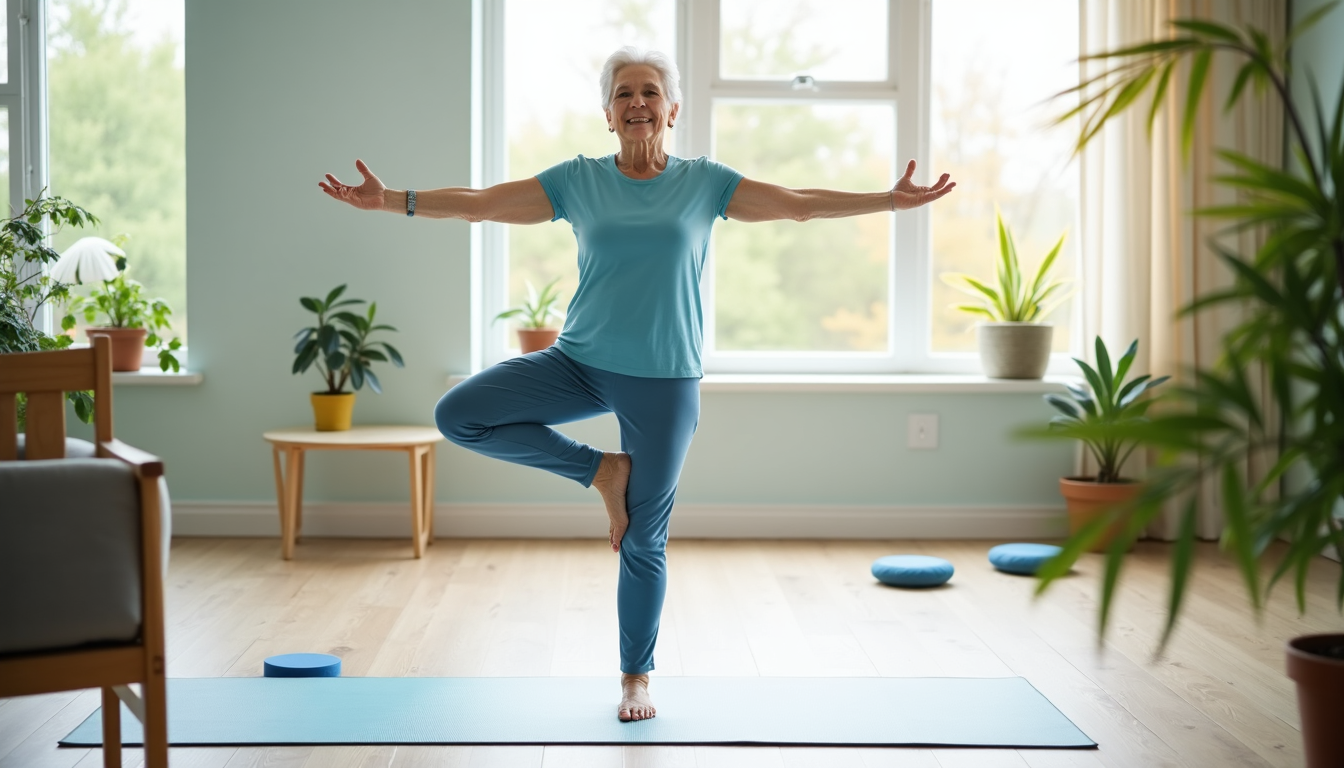The statistics are alarming – one in four adults over 65 falls each year. These incidents result in 3 million emergency room visits annually.
Here’s some encouraging news: You can prevent most falls with proper balance training. Balance exercises for seniors do more than just reduce fall risks. They help seniors stay independent with daily tasks like walking, climbing stairs, and reaching for objects.
Starting a new exercise routine can feel daunting, especially with balance training. This complete guide features simple balance exercises that progress naturally from simple movements to more advanced techniques. These strength and balance exercises will boost your confidence and help you stay active, whether you want to prevent falls or boost your overall stability.
Your journey to better balance and reduced fall risk starts here. Let’s begin with the simple techniques.
Understanding Balance Fundamentals
Understanding balance fundamentals plays a significant role before you begin any exercise program. Your body’s stability mechanisms and their age-related changes deserve a closer look.
The Science Behind Balance and Aging
The balance system in your body works like a well-rehearsed orchestra where multiple components create perfect harmony together. This intricate balance symphony includes these key players:
- Visual system (eyes)
- Vestibular system (inner ear)
- Proprioceptive system (muscles and joints)
- Central nervous system (brain and spinal cord)
- Musculoskeletal system (muscles and bones)
Key Components of Balance Training
The design of balance exercises for seniors focuses on three vital elements that maintain stability together:
- Sensory Integration: Your body learns to use input effectively from eyes, ears, and joints
- Motor Control: Your body’s response to balance challenges improves
- Core Strength: Your postural muscles develop strength
Assessing Your Current Balance Level
A starting point assessment helps before you begin any strength and balance exercises for seniors. The “Time Up and Go” test provides a simple way to check your balance. The test involves standing from a chair, walking 10 feet, turning around, returning to the chair, and sitting down. Taking longer than 14 seconds might indicate an increased fall risk.
These fundamentals help create better exercise programs. Your balance systems naturally decline with age, but proper training can maintain and enhance your stability. Regular practice of easy balance exercises for seniors helps offset age-related changes and reduces your risk of falling.
Starting with Beginner Balance Exercises
You can start your trip to better balance with exercises that are safe and work well. These beginner-friendly movements will help you build a strong foundation for more advanced balance training.
Seated Balance Activities
Seated exercises provide a stable base and help build core strength. The Ball Sit and Rock works great as a starting exercise. You should sit on a stable chair and gently rock your hips from side to side for three minutes. Keep your spine straight. This exercise strengthens your core muscles without any risk of falls.
Supported Standing Exercises
After you feel comfortable with seated exercises, you can move to supported standing movements. These balance exercises for seniors need a sturdy chair or wall nearby for safety. Here are the exercises we recommend:
- Head Rotations: Stand tall, holding chair if needed
- Single-Leg Stance: Start with 10-second holds per leg
- Shoulder Rolls: Combine with breathing for relaxation
Simple Walking Drills
Dynamic balance improves with walking drills. The Heel-to-Toe Walk shows great results. Picture yourself walking on a straight line and place your heel directly in front of your toes with each step. You should take 20-30 steps this way. Use a wall for support if needed.
These exercises work best when you:
- Keep proper posture
- Move slowly and think over each movement
- Use support when needed
- Stop if you feel dizzy or unstable
Note that these strength and balance exercises for seniors follow a progressive approach. You should practice each exercise for 5-10 minutes daily. Reduce your reliance on support as your balance gets better.
Progressing to Intermediate Movements
You’ve mastered the simple exercises, and now it’s time to take on more advanced balance exercises for seniors. These intermediate movements will boost your stability and confidence in daily activities.
Single-Leg Balance Variations
Progress to more challenging single-leg exercises after you can hold a simple balance for 30 seconds. Here’s the recommended progression:
- Single leg balance with eyes closed (10 seconds)
- Multidirectional lunges (12-15 repetitions)
- Single leg balance with arm movements
- Balance with head turns
Dynamic Walking Exercises
Dynamic walking exercises help you stay balanced while moving. These exercises to improve balance for seniors include:
- Walking with controlled head turns and nods
- Side stepping with proper posture
- Heel-to-toe walking with varied speeds
- Multidirectional movement patterns
Stand tall and keep your core tight throughout these movements. Practice these exercises near a wall or sturdy surface to stay safe.
Core Stability Workouts
Core strength is vital for better balance. Strong core muscles lead to better posture and lower fall risk. Our recommended core exercises focus on:
Standing Core Exercises:
- Weight shifts with proper form
- Controlled trunk rotations
- Standing marches with core engagement
Best results come from doing these intermediate movements 2-3 times weekly. Begin with 10-15 repetitions of each exercise and gradually increase as you build strength and confidence. Your proper form matters more than speed or repetitions.
Steady breathing helps throughout each exercise. Don’t hesitate to use support when needed. These strength and balance exercises for seniors will challenge you while keeping safety as our top priority.
Advanced Balance Training Techniques
Advanced balance training techniques combine multiple skills that challenge your stability in new ways. These exercises need mastery of intermediate movements and professional supervision before you attempt them.
Multi-Directional Movement Patterns
Multi-directional movements can substantially boost your overall stability. Our advanced balance exercises for seniors has:
- Clock Reach Progression
- Start in center position
- Reach to 12 o’clock position
- Move clockwise, touching each “hour”
- Build up speed gradually while you retain control
Good posture remains vital throughout these movements as you challenge your balance system from different angles.
Reactive Balance Challenges
Reactive balance training helps prevent falls. Our dual-task exercises blend physical movements with cognitive challenges:
- Walking while catching/throwing a soft ball
- Stepping in response to verbal commands
- Balance board exercises with memory tasks
- Direction changes based on color signals
These strength and balance exercises for seniors boost your quick reactions to unexpected situations, which helps prevent daily falls.
Complex Coordination Drills
Advanced drills boost both physical and cognitive abilities at once. The progression has:
Dynamic Movement Combinations:
- Cross-body movements while standing on one leg
- Coordinated arm and leg patterns
- Weight shifts combined with head turns
- Multi-directional stepping with arm circles
Note that these advanced balance exercises for seniors need deep concentration and physical control. Practice them for 15-20 minutes, 2-3 times weekly. Keep proper support nearby and ensure you’re well-rested before trying these challenging movements.
Results improve when you add these exercises gradually to your routine. Begin with 5-minute sessions and extend them as you gain confidence. Switch back to intermediate-level exercises if you feel dizzy or uncomfortable until you’re ready to move forward.
Conclusion
Balance training is a vital part of healthy aging that gives seniors a clear path to independence and safety. Our guide shows how proper balance exercises can turn daily activities into confident movements.
You’ll start with basic seated exercises and work up to intermediate movements before taking on advanced balance challenges. Consistency makes all the difference – keep taking these exercises to strengthen your balance systems and feel more confident in your daily routine.
Your safety comes first. Focus on proper form and move gradually through each exercise level. Listen to your body and progress at your own pace while pushing yourself appropriately.
Regular practice of these balance exercises will improve your stability, strength, and mobility. You’ll develop the confidence you need for an active, independent lifestyle and substantially reduce your risk of falling.
FAQs
Currently, there are no frequently asked questions available related to the article “How to Master Balance Exercises for Seniors: A Step-by-Step Guide.” Please refer to the article for detailed information on balance exercises suitable for seniors, including beginner, intermediate, and advanced techniques.












